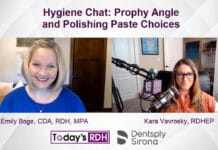It is a typical Monday morning, and your eight o’clock patient is running late, medical history needs to be updated, due for radiographs, annual full-mouth probing due, periodontal maintenance scheduled, and a doctor exam. Whew, that’s a lot to start the morning. As you begin the appointment, you work efficiently and as quickly as you can to get back on schedule for the nine o’clock patient who is on time. Finally, you complete your first patient, and you have several key notes on your mind, but they will have to wait until after the nine o’clock patient due to time.
As hygienists writing progress notes can be a daunting task in our profession. Now that you are at your computer you ask yourself what do I need to include, what is important? Well, what is important? We know the usual; medical history, the type of treatment completed, radiographs, doctor notes, but is that enough? How, as hygienists, could we improve upon progress notes without feeling rushed throughout the day?
Listed below are five suggestions on how to improve upon and expound on progress notes.
1) Medical History
Let’s say that your eight o’clock perio maintenance patient previously noted has asthma, diabetes, and high blood pressure. The patient’s medical history can be a guide and map to the oral cavity with correlations that need to be noted for overall health and periodontium health.
Asthma: Document the seemingly little things. Did they bring an inhaler to the appointment? Will the patient elaborate on what induces an attack? How frequently do they use the inhaler, daily or weekly? As hygienists, we know the drugs used to control asthma can lead to tooth decay and xerostomia. Asthma patients, especially children and their guardians, need to be informed about proper oral hygiene care after the use of an inhaler to minimize tooth decay and determine caries risk.
Diabetes: Documenting Type I/II diabetes could save a patient’s life in the possible event of a medical emergency. Patients with diabetes are at higher risk for perio disease due to poor sugar control. In addition, document the patient’s current A1C and blood glucose levels. This will help to educate the patient on the correlation between overall health and periodontium risks and health. This documentation serves as an aid for future appointments or critical notes for a different hygienist or office.
Blood Pressure: Document a patient’s blood pressure, especially unregulated high blood pressure. Several months ago, I saw a patient with high blood pressure. The patient informed me of the issue, and upon taking their blood pressure, it was 220/140. This needs to be documented! Noting the high blood pressure serves as a history and also an insight as to what the future oral health may be. A patient’s uncontrolled blood pressure can also be an educational tool when explaining that studies have shown where perio disease can worsen with high blood pressure.
2) Oral Hygiene Instruction
How do you ask your patient about their current oral hygiene regimen? In order to provide adequate oral hygiene instruction, you must ask the patient what they are doing at home. If your patient stated that they brush two times a day with a manual toothbrush, flosses once a week and does not use mouth rinse; then this needs to be documented. How will you know at their following visit if the patient has changed something in their oral hygiene regimen without documenting their prior history? As hygienists, we should document the patient’s oral routines and our recommendations as well.
Example note: Pt reports brushing 2x’s a day with a manual, medium bristle toothbrush/flossing with regular dental floss 2-3x’s a week/uses water flosser on occasion/doesn’t use mouth rinse. Pt was advised to use electric TB 2x’s a day for 2 min for better plaque removal over manual TB and soft bristle/use of traditional dental floss once in the evening, and water flosser with diluted antimicrobial without alcohol. Pt was shown proper tech and angulation for water flosser usage/antimicrobial mouth rinse 2x’s a day for 30 sec to reduce bacteria count in the mouth.
3) Oral Cancer Screening
As hygienists, we perform oral cancer screenings at every hygiene appointment. Tori, geographic tongue, ulcers, fistula, petechial, nicotine stomatitis, or oral trauma are a few examples of what should be added to your progress notes. Let’s say a patient has a 3x3mm nodule on the left, dorsal surface of the tongue that has been there for years. Although the patient stated that it is unchanging and has had it checked by an oral surgeon always make a note of these areas. Although these lesions are not “cancerous” noting these lesions are key in completing a patient’s overall progress notes and dental charting. In addition, note if the patient uses tobacco or has a prior history of use. This information needs to be included in the oral cancer screening notes along with how many packs or cans per day the individual uses and what length of time.
4) Type of Treatment Performed
When completing a progress note simply putting “prophy” doesn’t fully explain what happened during that appointment. Be elaborate and detailed in your notes as they will serve as a basis for future appointments.
Example note: Prophy: ultrasonic, handscale, polish-rubber cup/air polisher (mint used), flossed, and 5% NaF Fl varnish treatment.
5) Gingival Health
Again, simply stating: “Periodontal disease present” or “Healthy mouth” doesn’t explain a patient’s current gingival health. Writing notes describing the patient’s current oral health at the appointment will allow you to review prior notes to determine if the patient’s gingival health status has improved or declined. Include the AAP stage and grade. If your patients are like most, they are going to ask, “How do I look today?” Well, how do they look today? How will you know and be able to respond if you don’t record pocket depths or explain tissue health change?
Example note: Perio Maint: FMP (full mouth probed): 2-5mm pockets, generalized moderate recession noted on perio charting, generalized mod bone loss noted on radiographs. AAP stage 2, grade B, active moderate periodontitis. Class I mobility #18 and #19 and Class II mobility #30. Gingival tissue moderately inflamed with cratered tissue #’s 2-4 and boggy tissue #’s 22-27/crowding #’s 22-27/no improvement from prior periodontal charting, pt was made aware. Non-surgical periodontal therapy recommended…. PARQ… Etc.
If this patient uses tobacco the following needs to be stated: “Patient was made aware of the correlation between overall health and periodontium (oral cancer risks/perio disease).” If you don’t document this, then the conversation NEVER happened. What if your patient develops oral cancer and states you never explained to them that they had periodontal disease or discussed the correlation between periodontal disease, overall health, and oral cancer risk? Although you verbally discussed it with the patient, you have to record it in the patient’s charting as well.
Conclusion
Progress notes are one of the most important tasks for any dental hygienists. Although it is tasking and time consuming, writing the “perfect” progress note maps where the patients was orally and could offer insight as to where the health may be going. Think of your progress note as your appointment with the patient in writing. Make quick templates for the different types of treatment to cut down on time. Do not rush progress notes because of time constraints.
Remember, educating your patient on their oral health is a hygienist’s goal. As a medical provider, one cannot educate and advise without proper documentation, noting all aspects of the patient’s oral health.
Before you leave, check out the Today’s RDH self-study CE courses. All courses are peer-reviewed and non-sponsored to focus solely on high-quality education. Click here now.












